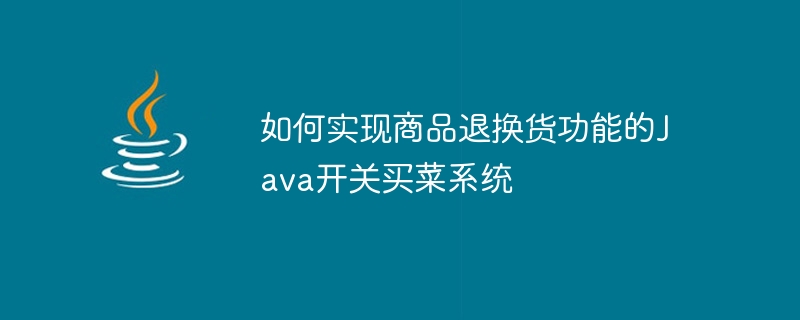Home >Java >javaTutorial >How to implement Java switch grocery shopping system with product return and exchange function
How to implement Java switch grocery shopping system with product return and exchange function
- WBOYWBOYWBOYWBOYWBOYWBOYWBOYWBOYWBOYWBOYWBOYWBOYWBOriginal
- 2023-11-02 11:07:581024browse

With the improvement of people's living standards, more and more people are paying attention to their dietary health and choose to buy their own ingredients to ensure food safety. With the development of the Internet, shopping for food online has become a fashion, and more and more people choose to buy food online. However, due to various reasons, sometimes the ingredients you buy are not what you need, and you need to return or exchange them. This article will introduce how to implement a grocery shopping system developed in Java that implements the product return and exchange function.
First of all, the grocery shopping system needs a complete product information management module. In this module, each product has its own unique identifier, and product information can be found through this identifier. Product information includes product name, price, origin, shelf life, etc. At the same time, the inventory quantity of each product needs to be recorded to facilitate statistics and management.
Next, the grocery shopping system needs a user management module. Users can log in through their account and password. After logging in, they can place orders, refunds, order inquiries and other operations. In the user management module, it is necessary to record the basic information of each user, including account number, password, contact information, etc., as well as the user's purchase history and refund record.
The grocery shopping system also needs to implement an order management module. When the user places an order, the system will generate an order and deduct the corresponding inventory quantity. If the user needs to return the goods, the system will generate a refund order and return the corresponding inventory quantity. In the order management module, the detailed information of the order needs to be recorded, including product name, price, quantity, order time, etc.
The key to realizing the product return and exchange function lies in the status management of the order. In the order status management module, different order statuses need to be defined, including order placed, shipped, completed, refunded, etc. When a user applies for a return, the order status needs to be set to Returned, and inventory returns and refunds must be processed based on specific circumstances. If the user purchases the same product again after returning the product, the system needs to determine whether the inventory is sufficient. If it is sufficient, the order will be placed normally. If it is not sufficient, it will prompt the user that the inventory is insufficient.
In addition, developing a grocery shopping system also needs to consider the handling of some special situations. For example, if a user returns a product and then cancels the return request, the system needs to set the order status to Completed and deduct the corresponding inventory quantity. Or, if the user applies for too many returns, the system needs to determine whether the returns are malicious after reaching a certain number, and handle them accordingly according to the situation.
To sum up, the Java-developed grocery shopping system that implements the product return and exchange function needs to start from modules such as product information management, user management, order management and order status management, and through reasonable design and implementation, Able to meet user needs and provide convenient return and exchange services. In this way, users can purchase ingredients online with more confidence and protect their dietary health.
The above is the detailed content of How to implement Java switch grocery shopping system with product return and exchange function. For more information, please follow other related articles on the PHP Chinese website!

